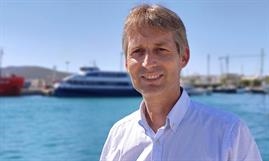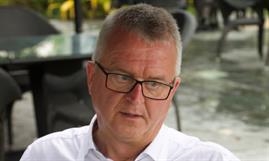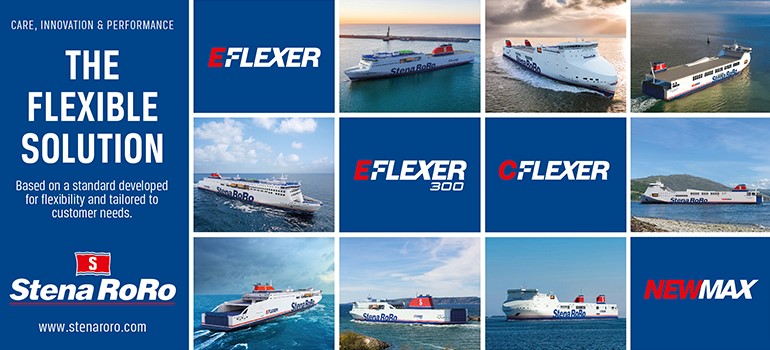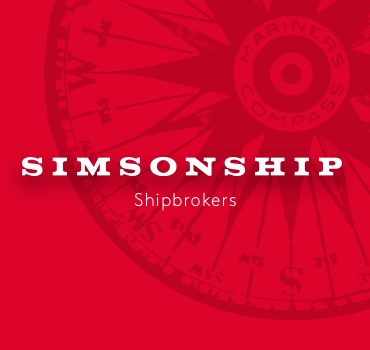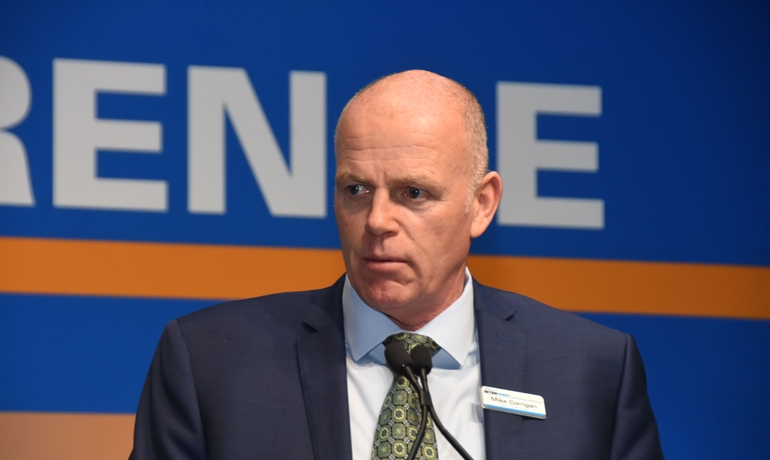
Mike Corrigan © Interferry, John Nedwidek
MORE THAN EVER STRONGER TOGETHER - AN INTERVIEW WITH INTERFERRY’S CEO
InterviewShippax’s editor talked to Interferry CEO Mike Corrigan, discussing what’s high on the ferry association’s agenda. As he explained, the outbreak of the COVID-19 pandemic changed the global trade body’s focus overnight.
Mike Corrigan became Interferry CEO on 1 April 2017 after a 14-year tenure with leading Canadian ferry operator BC Ferries, the last five years of which as CEO. In an interview with Shippax just after being appointed Interferry CEO, Corrigan said that besides increasing the exposure of the Interferry brand and organisation he would prioritise safety. So how does he look back upon his first three years at the helm of the global trade body?
“The task of Interferry CEO is to increase the presence and influence of the association across the globe,” he explained. “We have been around since the mid-1970s, being quite successful, but I was tasked to take it to the next level from an influential standpoint, getting more exposure at IMO and European Commission levels, as well as from flag states around the world, together with attention from our members and our supplier community.”
According to Corrigan, this was still a work in progress. “Since I took over, we have gone from about 200 to about 260 members – that’s an impressive 30 per cent increase,” he told us. “And the work will never be done as it’s one of those jobs where you can put as much time into it as you want. Considering the ferry industry only represents about three to five per cent of the overall shipping industry, we should be very proud of what we have achieved with a tonne of regulatory wins. It’s all about working together. If you don’t work together, you will not be able to get anything accomplished. Through Johan Roos’s regulatory office in Brussels, we have been able to increase our presence and our voice, specifically with the IMO and the European Commission. This has been very beneficial to our members and actually it has given them quite a good payback on their investment, their investment being the annual dues they pay as well as their commitment to come to meetings and participate in Interferry.”
Corrigan then underlined that, “We have got the organisation in really good financial shape. This is something that is important to the members. To do the things that you want to do, you need the resources, both the people and the dollars, to be able to do that. We’ve had three very successful conferences in a row which means we have money in the bank to be able spend on projects like domestic ferry safety and other things that are important.”
Getting its voice heard in Asia
Corrigan acknowledged that it was a challenge to get Asian ferry operators and suppliers on board. “We have been very successful in Europe,” he pointed out, “the majority of our members are European, and we have a good representation in other parts of the world, but Asia-Pacific is a region we want to get more members from in the next three years which is why we have been focusing on that area. We have attended safety conferences and participated in these in China and in Bangkok. We will actually host our own regional conference in that area. We were a co-sponsor of the IMO safety conference that was supposed to happen in Bangkok in March but which was cancelled due to COVID-19. The biggest initiative during the past three years was our domestic ferry safety initiative, aimed at improving safety in the developing world. Through the Domestic Safety Committee, one of our three subcommittees, we are putting ever more resources behind that all the time and it will even get more traction in the next three years. It’s the committee that we look towards to provide the leadership and drive for the domestic ferry safety initiative. I have personally been involved in that, as has Johan Roos. We have worked together with the IMO with whom we have a great relationship. They understand the leadership that we have taken on this matter. But it is fair to say that China and the Philippines have been leaders too. We are all working together towards this noble cause. Overall, there is more of a focus by everyone on safety now and we know that the Philippines, for example, are a leader in that regard. We have been working with the Philippines for some time now with Archipelago Philippine Ferries’ Chet and Mary Ann Pastrana and their organisation. They are taking a strong leadership role. We had a conference in Manila in 2016 and we worked with their maritime regulators and the coastguard. The primary thing that needs to happen with domestic ferry safety is that we need to have leadership at the top. The top has to start with the government and the regulators. They need to send clear messages within their countries that they will not accept poor performance around safety. This is happening in the Philippines and China. We also see Bangladesh starting to turn the corner.”
Whilst the Philippines, China and Bangladesh are making progress, there is still a long way to go when it comes to improving the safety level of ferries operating in Indonesian waters, something Corrigan admitted. “The Domestic Safety Committee was only formed a couple of years ago,” he clarified. “Together with the Lloyd’s Register Foundation we went to the Philippines last year to gain first-hand experience of the country’s safety improvements and see the lessons learned from these. The next step is to take this learning to other countries, so they can accelerate their safety culture. We are actually working with the Lloyd’s Register Foundation on a second application for what we call FERRYSAFE II, the Philippines ‘lesson learn’ project being known as FERRYSAFE I. FERRYSAFE II will take those lessons learned out to other countries. We will work with their influencers to get things changed in those countries. The country that we see most ripe for learnings and for improving their safety culture right now is Bangladesh. But, of course, a country like Indonesia is also on our screen. We have limited resources and you can’t eat an elephant in one bite.”
GHG emissions topping the agenda
Until the outbreak of COVID-19, the IMO’s two-pronged approach with regard to addressing greenhouse gas (GHG) emissions from international shipping was topping the Interferry agenda. “We thought that about 80 per cent of our time this year would be directed on the regulatory front towards the GHG initiative,” Corrigan explained. “Right now, the biggest thing on our agenda is dealing with the COVID-19 pandemic but it will not take too long before the GHG debate will need our attention again, especially with an Energy Efficiency Existing Ship Index (EEXI) looming. Our primary focus for the next few years is to make sure that the ferry industry is represented properly in this discussion. We want to be part of the solution in the long term as we are leading the shipping industry towards zero emissions. There are plenty of examples of ferry operators who are installing batteries or hybrid technology and we are also starting to move towards hydrogen. Ferries are leading the way, but there is a challenge around existing vessels and even the construction of new vessels and how things will work relative to the IMO targets for GHG emission reductions. There is a lot of work that needs to be done, but to tell you the truth, there are not a lot of answers out there at this point in time. From our industry’s perspective, we want to maintain as much flexibility as possible so our members can continue to operate. We are promoting different ways to achieving the EEXI target, but one shoe doesn’t fit every foot. Operators should be given flexibility to achieve the emissions reductions. Slow steaming has been suggested as one of the solutions. This may work for some, but not for everyone as schedules have to be maintained. It could be one of the tools in the toolbox, but it’s definitely not something we want to have mandated. It should be voluntary as other options are available whether through repowering vessels or investing in other technology that reduces emissions. Deep-sea cargo ships have more flexibility. As has been clearly demonstrated in these Coronvirus days, ferries need to get goods and services back and forth in a timely manner and they have schedules to keep.”
Weathering the COVID-19 storm
Speaking to Mike Corrigan when COVID-19 was peaking in Europe, the Interferry CEO said that the COVID-19 situation was the association’s number one priority at this very moment. “We have to make sure that our members have the support and the ability to be able to survive so that they can get back on their feet and continue to provide lifeline services that they need to provide as the economy starts to rebound,” he told us. “Seventy-five to 100 per cent of passenger ferry traffic has been shut down right now and over 50 per cent of vehicle traffic. The only traffic that is moving is essential goods and other services that need to get delivered to communities. Needless to say, operators are incurring mounting losses that are unsustainable over the long term.” Notwithstanding the doom and gloom brought by COVID-19, Corrigan thinks that the ferry industry may be one of the first sectors in shipping to recover because people will start travelling regionally or in their country before they travel internationally and jump on an aeroplane or a cruise ship. “People will want to start enjoying their lives again and they will go to places where they feel most comfortable which will be in their own countries and their own regions of the world,” he said. “We will be a big part of the solution to get economies back on their feet, which is a positive thing. The challenge is that nobody really knows how this virus will develop. In the Northern Hemisphere we are heading into the summer period. The weather gets nice and viruses start to hibernate, but then they come back in the fall. Who knows what a bounce back will mean? I have talked to operators that are putting contingency plans together that could last up to 18 months. The problem with COVID-19 is that we are all in this together, fighting this invisible enemy. We don’t have any control over it at this point in time. All we need to do, is do what we can, individually and as an industry. We need to make sure that the ferry industry is considered in those financial aid packages that individual countries are putting together. We will have losses in the billions of dollars. If there’s not some type of financial aid package, unfortunately, some of our operators might not be able to get back on their feet which would be extremely unfortunate. We have to make sure that our voice is heard and that we are doing everything we can to support the ferry industry overall. Rather than focusing on our members alone, we want to speak as the voice of the whole ferry industry. Of course, we would like to have every ferry company in the world being a member of Interferry. But regardless of whether you are or not, we do represent the global ferry industry and we will speak on behalf of it.”
Outlook post-COVID-19
When asked whether the COVID-19 crisis would lead to a further consolidation of the ferry landscape with the big operators getting bigger, Corrigan commented that we would have to wait and see. “There is an argument on both sides,” he said. “It makes sense that big companies would get bigger, but also smaller nimble companies that are well-managed, have good cash reserves and good financial structures in place, may do better than big ones that are highly leveraged. I think it will be on an individual basis and it will also depend on whether the companies are private or public. Companies that are owned by governments or are quasi-public will survive probably better than companies that are purely privately-owned. So, who knows what the real answer is? One thing is for sure, it will not be a one-size-fits-all.”
Corrigan predicts that there will be structural changes in every industry as a result of COVID-19. “People will take time to review their overall business models as well as their customer bases. I think certain companies will look different coming out of this than they did going into it, that’s the reality.”
Notwithstanding COVID-19 having changed the ferry industry overnight, Corrigan is rather positive about its future in the longer term. “Leading up to the COVID-19 situation, the ferry industry was in excellent shape globally,” he explained. “We were growing our customer base on a year-over-year basis, probably leading the shipping industry in newbuilds as everybody was building new tonnage. We were also leading the industry in the push towards zero emissions. So, we had everything going for us and we were set up very well to succeed over the long term. I do still believe that over the long term, we will succeed. What we don’t know though is how long it will take to come out of this COVID-19 situation. My best estimate is that it would take 18 months to two years to fully recover to where we were before. That’s just my personal opinion based from reading and talking to people. There are a lot of people who have lost their jobs, either temporarily or long term – if you take that amount of consumer spending out of the market place, the economy will take a while to recover. But humans are resilient and people have short memories and I’m not sure if that’s a good or a bad thing – we will talk about this for the rest of lives, but people tend to look forward as opposed to backwards. The way consumers behave will change to a certain degree. But just as the market goes up and down, it always seems to recover over the long term. This is because there is a lot of wealth in this world and there still will be over the long term and people want to invest those dollars somewhere. They want to enjoy their lives. We are humans and we are built to survive. To be positive, and I think that’s what I would say about the ferry industry in general; we are all in this together and we want to do things right to get through it. It really comes back to my message when I took over: ‘stronger together’, right? That’s what we need to be. We are a small part of the overall shipping industry, so we need to make sure that we stick together and represent the industry as best as we can.”
Call for more members
Although Corrigan always wants to reach out to people who are members, he also had a message for those who have not joined yet. “We do represent the entire ferry industry,” he underlined. “We need people to be members because we need to have strength but, at the same time, it’s good to have the financial wherewithal to be able to do what we need to do. There are still some operators out there who aren’t members of Interferry and who I would ask to consider joining. They are still getting the benefit but it’s better to be part of an organisation like ours. They get to influence what we do and the priorities of where we focus our energies. At Interferry, members get a voice at the table in terms of the messaging that we put out, and they are part of the family. The ferry industry, more than any other industry I have ever been involved in, really is a family. Everybody cares about everyone else because we are still somewhat regionalised people with a sense of camaraderie. To those companies that are not a member yet, I would say: consider coming on board and helping us to continue to achieve the critical mass that we need to have to be able to do the good work that we do across the globe.”
© Shippax / Philippe Holthof
jul 01 2020
Most read
Scottish government to nationalise Ardrossan Harbour and carry out major upgrading programme to be able to dock new CalMac ferries
jan 09 2026


